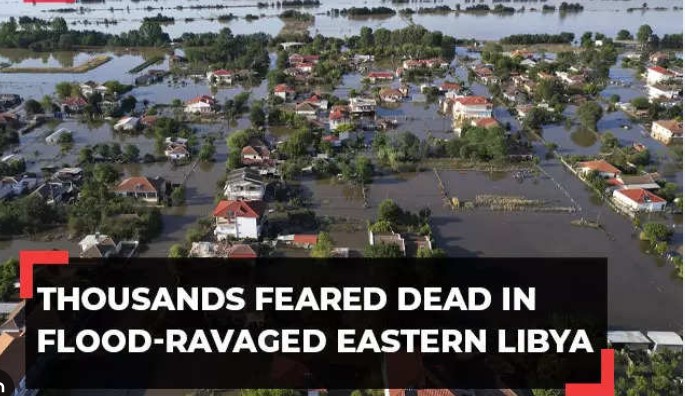Virendra Pandit
New Delhi: Although nearly 6,000 people have died in the recent Libya floods, some estimates suggest the death toll could be much higher, around 20,000, the media reported on Thursday.
According to a BBC report, the toll could be as high as 20,000.
Mediterranean storm Daniel caused deadly flooding on Sunday night in many towns of eastern Libya, but the worst hit was Derna, the port city with a population of nearly 90,000.
Two dams in the mountains above the city collapsed, sending floodwaters roaring down the Wadi Derna River and through the city center, sweeping away entire city blocks.
Search teams combed streets, wrecked buildings, and even the sea on Wednesday to look for bodies in the coastal Libyan city where the dams’ collapse suddenly unleashed a massive flash flood that killed hundreds instantly and washed away most access roads. Aid workers who managed to reach the doomed city described the devastation in its center, with thousands still missing and tens of thousands left homeless.
“Bodies are everywhere, inside houses, in the streets, at sea. Wherever you go, you find dead men, women, and children,” Emad al-Falah, an aid worker from Benghazi, said.
As much as a quarter of the city has disappeared, emergency officials said.
Waves rose as high as 7 meters (23 feet), Yann Fridez, head of the delegation of the International Committee of the Red Cross in Libya, told broadcaster France24.
Collapsed bridges over the river split the city center, further hampering movement. Search teams combed through shattered apartment buildings and retrieved the dead floating offshore in the Mediterranean Sea.
According to early reports, Ossama Ali, a spokesman for an ambulance center in eastern Libya, said at least 5,100 deaths were recorded in Derna, along with around 100 others elsewhere in eastern Libya. More than 7,000 people in the city were injured. The death toll could increase since teams are still collecting bodies, At least 9,000 people are missing, but that number could drop as communications are restored.
Another 30,000 people in Derna were displaced by the flooding, the UN’s International Organization for Migration said.
The devastation pointed to the storm’s intensity, but also Libya’s vulnerability.
The country is divided by rival governments, one in the east, the other in the west, and the result has been neglect of infrastructure in many areas.
Derna is 250 kilometers east of Benghazi, where international aid started arriving on Tuesday.
Neighboring Egypt, Algeria, and Tunisia, as well as Turkey, Italy, and the United Arab Emirates, sent rescue teams and aid. The UK and German governments sent assistance too, including blankets, sleeping bags, sleeping mats, tents, water filters, and generators.
President Joe Biden also said the United States would send money to relief organizations and coordinate with Libyan authorities and the United Nations to provide additional support.
The victims’ lists reflected how Libya, despite its turmoil, was always a magnet for workers from around the region because of its booming oil industry. More than 70 of Derna’s dead hailed from a single southern Egyptian village, el-Sharif.
Derna, about 900 kilometers east of the capital, Tripoli, is controlled by the forces of powerful military commander Khalifa Hifter, who is allied with the eastern Libyan government. The rival government in western Libya, based in Tripoli, is allied with other armed groups.
Derna was once a hub for extremist groups in the years of chaos that followed the NATO-backed uprising that toppled and killed longtime dictator Moammar Gadhafi in 2011.

